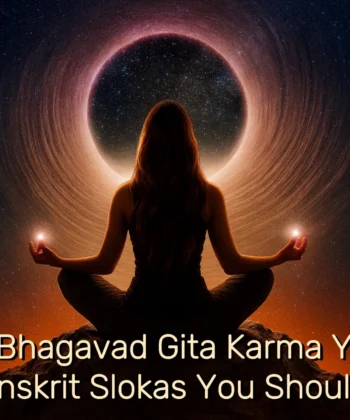
Table of Contents
Kundalini yoga is often called “yoga of awareness” because it emphasizes using movement, breathing, and meditation to awaken the energy inside the body. Because of its powerful mental and physical benefits, this centuries-old practice – which has its roots in spiritual and physical transformation – has grown in popularity. But there are a lot of controversies around it, like “Is Kundalini Yoga dangerous?” and “Is it a cult?” Coming again and again.
I’ll go over what you need to know in this tutorial on doing Kundalini Yoga at home safely. This brief excerpt will help you confidently begin your adventure, from learning about this beginner-friendly routine to understanding its roots and benefits. This step-by-step guide will provide you with all the information you need, whether you’re new to Kundalini Yoga or want to advance your practice. Let’s get started!
What is Kundalini Yoga?
Kundalini Yoga is not just a practice—it’s an awakening. Imagine a slumbering serpent coiled at the base of your spine – not something to be feared, but the symbol of Kundalini, the unmanifest potential humming within. In Kundalini Yoga, this “snake” moves, unleashing a transformative energy that goes beyond physical postures. More than just a workout, it is a journey inward, using breath, movement, mantra, and meditation to peel back layers of perception and awaken intuitive awareness, offering a glimpse of the “third eye” and the boundless potential it discloses. But tread mindfully; this potent practice demands respect and guidance, for awakening this sleeping giant requires a body, mind, and spirit prepared for its profound and electrifying dance.
Preparing for a Transformative Kundalini Yoga Journey
So, you are ready to experience the energy of Kundalini Yoga! But before you dive into the breathing exercises and actions, let’s set the stage for a truly powerful and rewarding practice. Think of it as creating a sacred space within yourself and your surroundings. Here’s how to create the ideal environment and gather the essentials for your Kundalini Yoga adventure:

Choosing the Right Space
The Vibe Matters: Your practice space should feel safe, supportive, and conducive to introspection. Seek out a spot where you can minimize distractions and connect with your inner self.
Cleanse & Clear: Before each session, take a few moments to tidy up your space. Clutter can energetically weigh you down. Open a window to invite fresh air and consider smudging with sage or palo santo to clear any stagnant energy.
Nature’s Touch: If possible, incorporate elements of nature into your space. A plant, a crystal, or even a view of the sky can enhance your connection to the earth and the cosmos.
Sacred Geometry (Optional): Some practitioners believe that arranging your space according to sacred geometry principles can amplify the energetic flow. Do some research on symbols or formations that resonate with you.
Sound Healing (Optional): Play ambient music to help ground you in your place. Solfeggio Frequencies are great!
What to Wear to Kundalini Yoga
- Comfort is Key: Choose clothing that allows you to move freely and breathe deeply. Avoid anything too tight or restrictive.
- The Power of White (Often Recommended): White clothing is often encouraged in Kundalini Yoga. It’s believed to expand your aura and promote a sense of purity and calm.
- Natural Fabrics Preferred: Opt for natural fibers like cotton or linen, which are more breathable and allow energy to flow more easily.
- Layers for Comfort: Your body temperature may fluctuate during practice, so layering your clothing can help you adjust as needed.
- Respectful Attire: Choose clothing that reflects reverence for yourself and the practice.
Essential Items for Kundalini Yoga
- The Foundation: Yoga Mat
- Invest in a high-quality yoga mat that provides cushioning and support. Look for one that’s non-slip to prevent injuries.
- A Seat of Presence: Cushion or Meditation Pillow (Zafu)
- A cushion or zafu can provide comfortable support for seated postures and meditation. Choose one that elevates your hips slightly, allowing your spine to align naturally.
- Crown of Consciousness: Head Covering (Optional, But Often Recommended)
- A head covering, such as a turban or scarf, is a common practice in Kundalini Yoga. It’s believed to focus energy and protect the crown chakra. White is often preferred, but any natural fiber that feels comfortable will work.
- Optional additions:
- Mala Beads can be used for Mantra repetition
- Crystals can amplify the power of poses and meditation
- Essential Oils can help you stay calm and grounded
- Hydration:
- Have water nearby
Exploring the Multifaceted Benefits of Kundalini Yoga

Beyond the poses and breath, Kundalini Yoga gives you many benefits for both your body and mind. By putting specific postures, breathwork, meditation, and chanting into your practice, you can feel changes that go beyond just being physically fit.
One big thing about Kundalini Yoga is that it helps balance and strengthen your nervous system. The dynamic movements, along with deep breathing, help control the energy flow in your body. This makes you feel calmer and reduces stress.
Doing Kundalini Yoga can also sharpen your mind and help you focus better. Moving and being aware simultaneously creates a greater understanding that you can use in your daily life. With better awareness, you may make better decisions and feel better mentally overall.
Also, practicing Kundalini Yoga regularly can make you more flexible and stronger, and give you more stamina. The different poses work on different muscles and make your joints more mobile. As you get more physically fit through this practice, you might have more energy and feel more alive.
Besides the physical stuff, Kundalini Yoga also helps you balance your emotions by letting go of tension stored in your body.
When you release this tension, you can feel more joy, love yourself more, and have better relationships with yourself and others.
Kundalini Yoga gives many benefits for people who want to be physically fit, grow spiritually, find themselves, and have inner peace.
3 Simple Ways for Practicing Kundalini Yoga at Home
Practicing Kundalini Yoga at home is not just about following a set of movements—it’s about creating a practice that fits seamlessly into your life. Whether you’re just starting or looking to deepen your practice, small, consistent steps can lead to profound change. Begin with short sessions, even five minutes, and gradually build from there. With patience and dedication, you’ll experience how Kundalini Yoga not only transforms your body but also strengthens your connection to your inner self.
1. Key Aspects:
- Self-Awareness: This practice encourages a deeper understanding of yourself and your connection to the world around you.
- Regular Practice: Even a short daily session can be beneficial.
- Inner Connection: The routine helps you tune into your inner self and access your own intuition.
2. The Practice:
1. Beginning with the Adi Mantra (Connecting to Your Inner Teacher)
- (Posture: Easy Pose – Sukhasana or Chair Pose): Sit comfortably with a straight spine. Choose a position that allows you to relax and focus.
- (Preparation): Gently rub your palms together to create warmth and balance. Then, bring your hands to your heart center, pressing your thumbs lightly against your chest.
- (Mantra): Chant “Ong Namo Guru Dev Namo” 3 times. This mantra is a way to acknowledge your inner wisdom and connect you with the lineage of teachers who have shared this practice.
- Meaning: “I bow to the creative wisdom, I bow to the divine teacher within.”
- (Integration): Inhale deeply, holding your breath comfortably while pressing your thumbs into your heart center. Exhale and rest your hands on your knees.
2. Energizing Breath: Four-Part Breath (Promoting Vitality and Clarity)
- (Posture: Easy Pose – Sukhasana or Chair Pose): Sit straight with your palms together at your heart center, fingers pointing upward. Maintain a relaxed but alert posture.
- (Focus): Gently close your eyelids and focus your attention inward, towards the space between your eyebrows (the third eye point).
- (Inhale): Divide your inhale into four equal parts, “sniffing” the air in with each part to fully fill your lungs. Engage your abdominal muscles by gently pulling your navel towards your spine with each sniff.
- (Exhale): Release your breath in four equal parts, emptying your lungs completely. Continue to engage your abdominal muscles by pulling your navel towards your spine with each part.
- (Duration): Continue this breathing pattern for 2-3 minutes. Try to maintain a smooth, steady rhythm.
- (Mental Focus (Optional): If your mind wanders, you can mentally repeat the mantra “Sa Ta Na Ma” with each part of the inhale and exhale.
3. Cultivating Inner Stillness: Silent Reflection
- (Posture: Comfortable Position – Chair or Cross-Legged): Choose a posture that allows you to be still and relaxed.
- (Action): Gently close your eyes and allow your attention to settle inward. You can focus on the sensation of your breath entering and leaving your body, or simply observe your thoughts and feelings without judgment.
- (Duration): Begin with five minutes of silent reflection and gradually increase the duration as you become more comfortable.
Breathe in deeply, then let it out fully.
3. Key Points to Remember:
- The most important thing is to begin and to maintain a regular practice.
- Pay attention to your body and adjust exercise activities accordingly.
- The focus is on cultivating inner awareness and connection.
Watch & Practice: Experience a full Classical Kundalini Yoga class with Yogrishi Vishvketu from Akhanda Yoga Institute! This guided session will help you deepen your practice, balance energy, and connect with your inner self. Follow along step by step!
Watch & Flow: Boost your creativity with this 30-minute Classical Kundalini Yoga session for the Sacral Chakra! This step-by-step guide will help you unlock energy, enhance inspiration, and deepen your practice.
Safety Tips and Precautions
1. Dress Code: (No Bare Shoulders Allowed! …Wait, Why?)
- Standard Guidance: Loose, comfy clothes. Cover your shoulders and spine. Barefoot preferred. Blanket for post-kriya bliss-outs.
- The Intrigue: Forget fashion. Covering the spine isn’t about modesty. Think of it as subtly directing the flow of energy – like guiding a river through a channeled course. Intrigued? The spine is more than just bone; it’s an energetic superhighway. Consider it a gentle suggestion, not a spiritual mandate. Experiment and listen to your body’s response.
2. Fueling Your Fire: The Kundalini Diet…Debate?
- Standard Guidance: No heavy meals 2-3 hours before. Mostly Sattvic (fresh, light) foods. Hydrate after kriyas.
- The Intrigue: Ditch the dietary dogmatism. Sattvic is great, but “rajasic” (slightly stimulating) foods? Perfectly acceptable in moderation. Think: fuel, not restriction. Kundalini works the body, so it needs energy. Post-kriya water isn’t just about hydration; it’s flushing the energetic system. Experiment with foods and pay attention to how they make you feel.
3. Breath is Boss: Pranayama Protocols (and the Tissue Box Dilemma)
- Standard Guidance: Breathe through the nose (unless specified). Keep tissues handy. Jal Neti (nasal cleansing) recommended.
- The Intrigue: Pranayama isn’t just breathing; it’s energetic alchemy. The nose-breathing thing? It filters and warms the air, maximizing its impact. The tissues? Prepare for release. Jal Neti? Consider it “clearing the pipes” for optimal energy flow.
4. The Danger Zone: Navigating the Tricky Terrain
- Standard Guidance: Warm-up is essential. Don’t overdo it! Listen to your body. Modify poses.
- The Intrigue: This isn’t a competition. It’s a conversation with your inner self. Those challenging kriyas? They’re designed to push boundaries, not break them. Modifications aren’t weaknesses; they’re smart choices. Think: progression, not perfection.
5. Respect the Source: Honoring the Ancient Wisdom (and Avoiding Premature Awakening)
- Standard Guidance: Learn from a teacher. Trust the process. Don’t force the awakening.
- The Intrigue: Kundalini awakening isn’t a sprint; it’s a marathon. This practice is designed to prepare your system, not shock it. Trust the flow of events!
6. The When & Where of Kundalini: Time and Place Protocols
- Standard Guidance: Early morning (Brahmamuhurta) is ideal. Practice in a clean, ventilated space.
- The Intrigue: Brahmamuhurta = “The Divine Time” – the air is filled with prana (cosmic life force). But don’t sweat it if mornings are impossible. The intention is key. Create a space that feels sacred, even if it’s just a corner of your bedroom.
7. Tool Time: The Kundalini Toolkit
- Standard Guidance: Inspirational music (but not during meditation), cushions, mats, blocks, straps.
- The Intrigue: These aren’t just props; they’re extensions of your practice. The music sets the mood, the cushions provide comfort, and the blocks and straps offer support.Try out different options to find what works best for you.
8. Disclaimer: Safety First!
- Standard Guidance: No alcohol/drugs. If you are pregnant or taking medication, please consult a doctor.
- The Intrigue: Awakening Kundalini is a potent process. Think of alcohol and drugs as throwing fuel on a fire when you haven’t built a safe container.
Your Inner Guru Awaits:
Kundalini Yoga is a powerful path, but it’s your path. This guide is a starting point, not a rigid rulebook. Listen to your body, trust your intuition, and enjoy the adventure. Trust in your inner guidance to lead the way.
Closing: Kundalini Yoga – A Journey Inward, Supported Outward

You’ve just embarked on more than just a yoga routine; you’ve taken the first steps towards awakening your inner potential. Remember, this journey isn’t about achieving perfect poses or mastering complex kriyas overnight. It’s about cultivating a deeper connection with yourself, tuning into the subtle whispers of your body, and allowing the potent energy of Kundalini to gently unfold within you.
Treat this routine as a springboard, not a rigid prescription. As you grow more comfortable, explore modifications, adjust timings, and most importantly, listen to your intuition. Let curiosity guide your exploration, and don’t be afraid to experiment with other beginner-friendly kriyas and meditations.
The true magic of Kundalini Yoga lies not in the external movements, but in the transformative shift within. Have patience, treat yourself with kindness, and have faith in the process. As you consistently practice, you’ll begin to witness a profound awakening of energy, clarity, and inner peace, empowering you to navigate life with newfound grace and vitality. Embrace the journey, and welcome the unfolding of your awakened self.
Also Read: How to Start Ashtanga Yoga? A Step-by-Step Guide for Excited Beginners
Also Read: Somatic Yoga for Beginners
Also Read: Chakra Yoga for Beginners: Unlock 7 Chakras in Human Body and Their Significance




